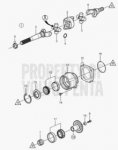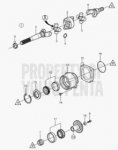jastacdoss
Cadet
- Joined
- Apr 4, 2012
- Messages
- 8
Volvo Penta 3.0gspefs with sx-m 1.97. Had to remove input shaft bearing carrier due to leaking seal. When I removed the outdrive the tabs on the bearing carrier were snapped off so I purchased all new bearings and housing. I am now in the process of putting everything back together.
My question is how do I measure the rolling torque? I have searched this forum and google and can only find references to what the rolling torque should be, not how to do it. What I have gathered thus far...
Tighten the shaft nut to 140ft-lb initially and check rolling torque and tighten 1/16 of a turn and recheck until 6-10 in. lbs rolling torque is achieved.
Is this as simple as turning the bolt with an in-lb torque wrench set at 6in-lb while the carrier housing is in a vise?
appreciate your help!
My question is how do I measure the rolling torque? I have searched this forum and google and can only find references to what the rolling torque should be, not how to do it. What I have gathered thus far...
Tighten the shaft nut to 140ft-lb initially and check rolling torque and tighten 1/16 of a turn and recheck until 6-10 in. lbs rolling torque is achieved.
Is this as simple as turning the bolt with an in-lb torque wrench set at 6in-lb while the carrier housing is in a vise?
appreciate your help!






















